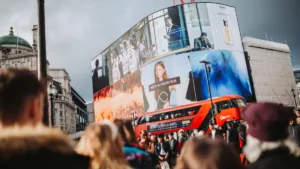By Luke Taplin-McCallum of AudioMob
AudioMob, an in-game audio advertising platform, has collaborated with market research and data analytics firm YouGov and digital assurance service Go Live Test, for insights on utilising audio ads through mobile games for advertising campaigns. Alongside providing a general overview of the modern in-game ads landscape, six key findings proved the potential of non-intrusive audio ads lifting monetisation and ad engagement, without interrupting gameplay.
Understanding Mobile Gamers Music Listening Habits
61% of 18 to 24-year-olds (who currently make up a vast majority of gaming audiences) listen to music whilst gaming. Meanwhile, nearly 50% of 24-to-34-year-olds and 44% of adults ranging between 35-to-44 share the same listening habits. Those in the 45-to-54 bracket also enjoy gaming whilst listening, with 34% doing exactly that. It makes sense for younger players to make up a larger proportion of the overall mobile gaming audience considering recent trends. That being said, the fastest-growing segments seem to be females and those in their 30’s.
Ultra popular battle-royal shooter Fortnite reached a new pop-culture apex in early 2019 when electronic dance music pioneer Marshmello became the first artist to present a live in-game performance. Since then, A-list artists ranging from Ariana Grande to Travis Scott have all performed on these platforms for free. Placing these multi-platinum recording artists in front of Fortnite’s 350 million player-base introduced new ideas regarding digital advertising. With around 116 million players or nearly half its player base utilising the cross-platform game’s mobile edition, the moment also broke conversations about mobile gaming viability. Some dubbed the concerts as being a part of the audio revolution. Mobile devices are playing a huge role in how consumers engage with audio – especially in mobile games.
Since the rise of mobile gaming with 2.8 billion mobile gamers worldwide, data has shown that these individuals spend an average of 26 minutes playing everything from Hearthstone: Heroes of Warcraft to Candy Crush Saga. Free-to-play mobile games have traditionally used video and banner ads to successfully monetise over the years. The biggest problem with those styles of ads is that they either block gameplay leading to frustrated players and lower retention rates. On the other hand, banner ads are less intrusive yet offer limited engagement.
Mobile Game Ad Preference
There’s a real connection between audio communication and consumer engagement. According to the BBC, consumer engagement reaches 18% when listening to branded audio with emotional intensity reaching 40%. From digital concerts in Fortnite to the rise of podcasts and audiobooks, new technology is pushing audio into new creative landscapes. This includes mobile games as well.
More users prefer audio ads to video ads or in-app purchases according to the study. The YouGov study revealed that while 18% of mobile users prefer video ads in games, 26% favour IAP and 28% see audio ads as their preferred monetisation model. The most important key finding in the study is that 75% of mobile users prefer audio ads to video ads in mobile games. All of those players within the focus group could recall what was being advertised as well.
This proves the potential of non-intrusive audio ads lifting monetisation and ad engagement without interrupting gameplay There are also long-lasting effects as 100% of users studied by Go Live Test continued to play while hearing audio ads and could all recall what was advertised.
How The Data Translates Into The Real World
The data provided showed that the audio ad format lent itself to an average click-through-rate of over 1000% compared to standard banners. This means that whilst the audio platform affords gaming developers better monetisation of their free-to-play games, advertisers can reach new audiences whilst preserving the gaming experience.
Working with Warner Music Group to promote artist Joel Corry and MNEK’s latest single “Head & Heart,” AudioMob were able to deliver encouraging results. The targeted marketing tools allowed WMG to specifically reach 18-to-30-year-old mobile gamers in the UK alongside United States cities including New York, Los Angeles, Chicago and Miami.
Players of popular games like Scribble Rider would see the small interactive visual banner with audio ads that could take them to a landing page for the single. After the campaign started, we were able to optimise the ad which further levelled up its impact. By the end, the campaign lent itself to impressive numbers across click-through-rate and ad completion rate besides minimal bounce rate.









